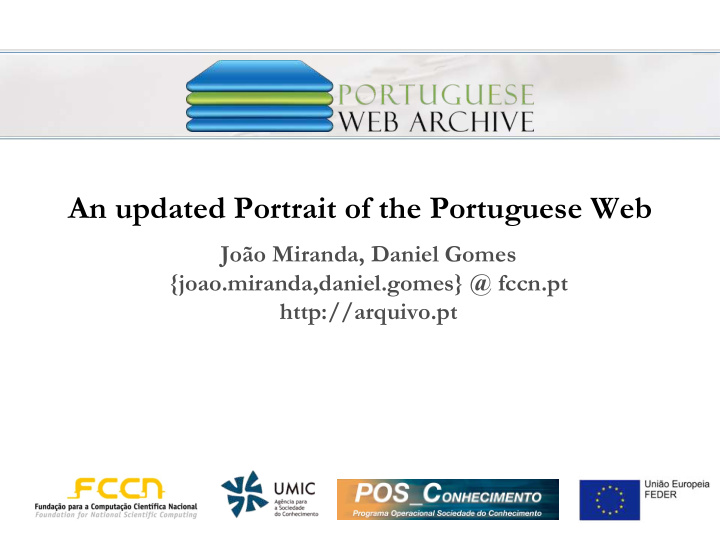



An updated Portrait of the Portuguese Web João Miranda, Daniel Gomes {joao.miranda,daniel.gomes} @ fccn.pt http://arquivo.pt
Summary • Introduction • Methodology • Metrics • Conclusions 2/28
3/28 Introduction
The Web • The Web is a huge source of information – Information published exclusively on the Web – Information disappears • Preservation started by the Web Archives – Access for future generations • First initiative: Internet Archive 4/28
Web Archives • Altavista across time 1997 1996 2004 1998 1999 2003 2009 2001 5/28
The Portuguese Web Archive • The Portuguese Web Archive Web archive User Content Crawler Indexer Web Interface Storage 6/28
Crawler • What is a crawler? – Collects contents from the Web – Starts from an initial set of addresses • How does it work? – Iteratively downloads contents – Extracts links to find new ones 7/28
8/28 Methodology
Methodology • Crawl of the Portuguese Web (March-May, 2008) – .PT domain – Heritrix crawler – 180 000 initial addresses – 48 million contents – 2.5 TB • No content analysis, only log analysis 9/28
10/28 Metrics
Sites hosted per IP address – Why? • Politeness policies for crawling server1 server1 siteA siteA crawler crawler server2 siteB siteB server3 siteC siteC 11/28
Sites hosted per IP address - Results • 75% of the IP addresses host 1 site 2% >10 sites 23% ]1,10] sites 75% 1 site 12/28
Successful responses – Why? • Quality indicator • Large % of broken links mines trust of users 13/28
Successful responses - Results • 18% of the sites returned 100% OK responses 14/28
Media types – Why? • Browsers or document viewers for cellphones • Parsing and indexing for search engines 15/28
Media types - Results • 90% of the number •69% of the amount of of contents are html, data are html, pdf, jpeg jpeg, gif Media type % contents Media type % amount data 1 Text/html 57.8% 1 Text/html 35.4% 2 Image/jpeg 22.8% 2 App’n/pdf 17.9% 3 Image/gif 9.4% 3 Image/jpeg 16.1% 4 Text/xml 1.9% 4 Text/plain 4.2% ‐ Other 8.1% ‐ Other 26.4% 16/28
Content size – Why? • Estimate the storage resources required to create Web data repositories 17/28
Content size - Results • 96% lower than 128 KB 18/28
Dynamically generated contents – Why? • Identify technological trends in Web publishing 19/28
Dynamically generated contents - Results • At least 46.3 % of the contents were dynamically generated 22.4% PHP 53.7% Not dynamically generated 10% ASP 0.9% JSP 13% Other with parameters 20/28
URL length – Why? • Influences interaction design • Determine adequate length for input boxes that receive URLs • How many characters should be presented on a search engine results page 21/28
URL length - Results • 84% lower than 100 characters 22/28
23/28 Conclusions
Conclusions I • Long URL addresses • Half of the contents are dynamically generated (mainly PHP) • 90% of the contents are HTML, JPEG and GIF • 69% of the amount of data are HTML, PDF and JPEG 24/28
Conclusions II • 96% of the contents are smaller than 128 KB • Half of the sites present a successful response rate below 80% • Most IP addresses host a single site 25/28
“Future” work • Study trends in the evolution of web characteristics –João Miranda, Daniel Gomes, Trends in Web characteristics, 7th Latin American Web Congress • Analyze metrics extracted from content and link analysis 26/28
Contribute to preserve the Web • Anyone can contribute to preserve the Web • Lend disk space to keep backup copies – Just need to install rARC – http://arquivo.pt/rarc • Help required to test beta version 27/28
Thank you. Logs used in this study are available for research purposes. Please contact us. http://arquivo.pt 28/28
Recommend
More recommend